Every chapter available in the Samacheer Kalvi Class 11th Bio Botany Solutions subject is explained clearly in an easy way. Learn the depth concept by referring to the Samacheer Kalvi 11th Bio Botany Solutions Chapter 15 Plant Growth and Development Questions and Answers. Have a look at every topic and get the complete knowledge on the Bio Botany Solutions subject. You do not need to search for many materials for a better understanding of Bio Botany Solutions. Just refer to Tamilnadu State Board Solutions pdf and have a grip on the total subject.
Tamilnadu Samacheer Kalvi 11th Bio Botany Solutions Chapter 15 Plant Growth and Development
I believe that the best book is like a best friend to know the complete world by sitting in one place. When you have the best book you have many options to get great knowledge. Selecting the best book will lead to reaching your goal. Students who are looking for the best book to learn Bio Botany Solutions can use Samacheer Kalvi Class 11th Bio Botany Solutions Chapter 15 Plant Growth and Development Questions and Answers. Immediately start your learning with Samacheer Kalvi Class 11th Bio Botany Solutions Solutions Pdf.
Samacheer Kalvi 11th Bio Botany Plant Growth and Development Text Book Back Questions and Answers
Question 1.
Select the wrong statement from the following.
a) Formative phase of the cells retain the capability of cell division.
b) In the elongation phase development of central vacuole takes place.
c) In maturation phase thickening and differentiation
d) In maturation phase, the cells grow further.
Answer:
d) In the maturation phase, the cells grow further.
Question 2.
If the diameter of the pulley is 6 inches, length of pointer is 10 inches and distance travelled by pointer is 5 inches. Calculate the actual growth in length of plant:
(a) 3 inches
(b) 6 inches
(c) 12 inches
(d) 30 inches
Answer:
(a) 3 inches
Question 3.
In unisexual plants, sex can be changed by the application of:
(a) ethanol
(b) cytokinins
(c) ABA
(d) auxin
Answer:
(c) ABA
Question 4.
Select the correctly matched one:
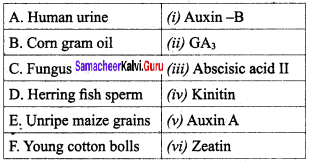
(a) A – (iii), B – (iv), C – (v), D – (vi), E – (i), F – (ii)
(b) A – (v), C – (ii), D – (iv), E – (vi), F – (iii)
(c) A – (iii), B – (v), C – (vi),D – (i), E – (ii), F – (iv)
(d) A – (ii), B – (iii), C – (v), D – (vi), E – (iv), F – (i)
Answer:
(b) A – (v), C – (ii), D – (iv), E – (vi), F – (iii)
Question 5.
Seed dormancy allows the plants to
a) overcome unfavourable climatic conditions
b) develop healthy seeds
c) reduce viability
d) prevent deterioration of seeds
Answer:
(a) overcome unfavourable climatic conditions
Question 6.
What are the parameters used to measure growth of plants?
Answer:
- Increase in length or girth (roots and stems)
- Increase in fresh or dry weight
- Increase in area or volume (fruits and leaves)
- Increase in number of cells produced.
Question 7.
What is plasticity?
Answer:
Plants follow different pathways in response to the environment or phases of life to form different kinds of structures. This ability is called plasticity,
eg : Heterophylly in cotton and coriander. In such plants, the leaves of the juvenile plant are different in shape from those in mature plants.
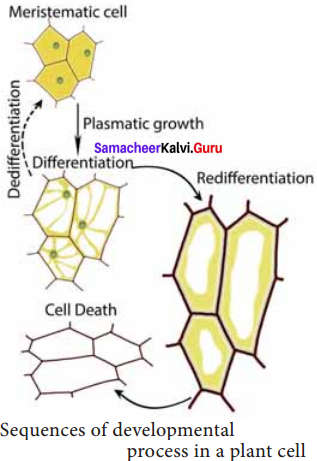
On the other hand, the difference in shapes of leaves produced in air and those produced in water in buttercup also represent the heterophyllous development due to the environment. This phenomenon of heterophylly is an example of plasticity.
Question 8.
Write the physiological effects of Cytokinins:
Answer:
Promotes cell division:
Cytokinin, in the presence of Auxin (IAA), promotes cell division.
Induction of cell enlargment:
Associated with IAA and Gibberellins induces cell enlargement
Breaks dormancy:
It can break the dormancy of certain, light-sensitive seeds and induces germination. Eg. Tobacco
Lateral growth:
It promotes the growth of lateral buds even in the presence of Apical bud.
Delays Aging:
It’s an application, delays – aging by nutrient mobilization – It is known as Rich mond Lang effect Various other activities, such as
- Increases rate of protein synthesis
- Induces the formation of interfascicular cambium
- Overcomes apical dominance
- Induces the formation of new leaves, chloroplasts, and lateral shoots
- accumulation of solutes.
Question 9.
Describe the mechanism of photoperiodic induction of flowering.
Answer:
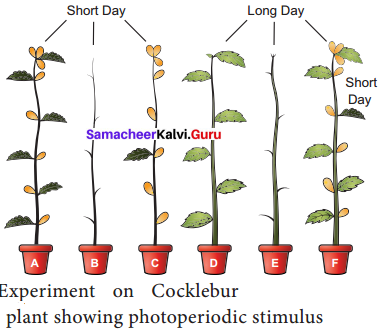
The photoperiodic stimulus is perceived by the leaves. The floral hormone is synthesised in leaves and translocated to the apical tip to promote flowering. This can be explained by a simple experiment on Cocklebur (Xanthium pensylvanicum), a short-day plant. Usually, Xanthium will flower under short-day conditions. If the plant is defoliated and kept under short-day conditions it will not flower.
Flowering will occur even when all the leaves are removed except one leaf. If a cocklebur plant is defoliated and kept under long-day conditions, it will not flower. If one of its leaves is exposed to short-day conditions and rest are in long-day conditions, flowering will occur.
Question 10.
Give a brief account of Pr grammed Cell Death (PCD).
Answer:
Getting old or aging is called senescence.
- Senescence is controlled by plants own genetic programme and death of the plant or plant part consequent to senescence is called Programmed Cell Death. In short senescence of an individual cell is called PCD.
- The proteolytic enzymes involving PCD in plants are Phytapases and in animals are caspases. Lhe nutrients and other substrates from senescing cells and tissues are remobilized and reallocated to other parts of the plant that survives.
- The protoplasts of developing xylem vessels and tracheids die and disappear at maturity to make them functionally efficient to conduct water for transport.
- In aquatic plants, aerenchyma is normally formed in different parts of the plant such as roots and stems which enclose large air spaces that are created through PCD.
- In the development of unisexual flowers, male and female flowers are present in earlier stages, but only one of these two completes its development while the other aborts through PCD.

Samacheer Kalvi 11th Bio Botany Plant Growth and Development Additional Questions & Answers
I. Choose the correct answer (1 Mark)
Question 1.
Geometric growth represents …….. graph
a) J – Shaped
b) S-Shaped
c) bell Shaped
d) liner graph
Answer:
b) S-Shaped
Question 2.
Bamboo is classified under:
(a) monocarpic annual plants
(b) polycarpic perennials
(c) monocarpic perennials
(d) polycarpic annual plants
Answer:
(c) monocarpic perennials
Question 3.
Auxin synthesis occurs in
a) root / shoot tips
b) Cortex
c) Xylem
d) Phloem
Answer:
a) root /shoot tips
Question 4.
One single maize root apical meristem can give rise to more than:
(a) 17,500 hew cells per hour
(b) 18,500 new cells per hour
(c) 19,000 new cells per hour
(d) 500 new cells per hour
Answer:
(a) 17,500 hew cells per hour
Question 5.
The Precursor for plant hormone Gibberellins is
a) Tryptophan
b) Acetyl CoA
c) Succinyl CoA
d) Histidine
Answer:
b) Acetyl CoA
Question 6.
When dying total growth of a plant is plotted against time, the shape of the curve obtained is:
(a) hyperbolic curve
(b) ‘S’ shaped sigmoid curve
(c) linear curve
(d) none of the above
Answer:
(b) ‘S’ shaped sigmoid curve
Question 7.
The chemical substance with the molecular structure of carotenoid ………….. is
a) Gibberellins
b) Ethylene
c) ABA
d) Cytokinin,
Answer:
c) ABA
Question 8.
Internal factors, that influence the growth of the plant is:
(a) nutrition
(b) light
(c) C / N ratio
(d) oxygen
Answer:
(c) C / N ratio
Question 9.
In decapitated plants, axillary buds are activated because,
a) Absence of auxin
b) More food material as available to them
c) Amount of Cytokinin increases in them
d) They get more light
Answer:
a) Absence of Auxin
Question 10.
Differentiated cells, after multiplication again lose the ability to divide and mature to perform specific functions. This is called:
(a) plasticity
(b) differentiation
(c) dedifferentiation
(d) redifferentiation
Answer:
(d) redifferentiation
Question 11.
The synthetic hormone used as weedicide Is
a) Indole -3 Acetic Acid
b) Gibberelic Acid
c) 2- 4 Dichiorophenoxy Acetic Acid
d) Malic hydrazide
Answer:
c) 2- 4 Dichiorophenoxy Acetic Acid
Question 12.
Some of the polyamines are known to behave like:
(a) growth inhibitors
(b) plant hormones
(c) flowering inhibitors
(d) fruit ripening agent
Answer:
(b) plant hormones
Question 13.
In tissue culture, differentiation of root and shoot can be controlled by
a) Modifying Auxm and Cytokinin ratio in the medium
b) Using ABA and Ethylene
c) Giving temperature shocks
d) Changing in light intensity
Answer:
a) Modifying Auxin and Cytokinin ratio in the medium
Question 14.
Phytohormones are usually produced to in tips of:
(a) root alone
(b) stem alone
(c) leaves alone
(d) root, stem and leaves
Answer:
(d) root, stem and leaves
Question 15.
This is an Anti auxin compound
a) 2.4.D
b) TIBA
c) GA3
d) PAA
Answer:
b) TIBA
Question 16.
Indole Acetic Acid (IAA) is a:
(a) growth inhibitor
(b) hetero auxin
(c) root inhibitor
(d) synthetic auxin
Answer:
(b) hetero auxin
Question 17.
The term Phytochrome was coined by
a) Garner
b) T.D.Lysenko
c) Skoog
d) Butler
Answer:
d) Butler
Question 18.
Auxin has a similar chemical structure of:
(a) Indole acetic acid
(b) Naphthalene acetic acid
(c) Phenylacetic acid
(d) 2,4 – Dichloro phenoxy
Answer:
(a) Indole acetic acid
Question 19.
Ripe banana contains a large amount of
a) ABA
b) IAA
c) IPA
d) Ethylene
Answer:
d) Ethylene
Question 20.
The term gibberellin was named by:
(a) Brain
(b) Yabuta
(c) Sumiki
(d) kurosawa
Answer:
(b) Yabuta
Question 21.
The term kinetin was coined by
a) Went
b) Haber landt
c) Skoog
d) Kurosawa
Answer:
c) Skoog
Question 22.
Formation of seedless fruits without fertilization is induced by:
(a) auxin
(b) cytokinin
(c) ethylene
(d) gibberellin
Answer:
(d) gibberellin
Question 23.
Which of the following types of Phytohormones resemble nucleic acid in some structural aspects?
a) Cytokinins
b) Auxins
c) Gibbervellins
d) Abscisic acid
Answer:
a) Cytokinins
Question 24.
Zeatin is first isolated from unripe grains of:
(a) paddy
(b) wheat
(c) maize
(d) com
Answer:
(c) maize
Question 25.
Which of the hormone is known as stress hormone?
a) Gibberellin
b) Kinetin
c) ABA
d) Auxin
Answer:
c) ABA
Question 26.
Aspartic acid is classified under:
(a) free auxin
(b) precursor of auxin
(c) chemical structure of auxin
(d) bound auxin
Answer:
(d) bound auxin
Question 27.
Which one of the following is Agent orange?
a) Colour used in a fluorescent lamp
b) Weddicide with Dioxin
c) Chemical used in luminous paint
d) Biodegradable insecticide
Answer:
b) Weddicide with Dioxin
Question 28.
The chemical structure of abscisic acid resembles the structure of:
(a) indole Acetic Acid
(b) malanic acid
(c) carotenoid
(d) xanthophyll
Answer:
(c) carotenoid
Question 29.
To increase sugar production in sugarcane, they are sprayed with
a) IAA
b) Cytokinin
c) Gibberellins
d) Ethylene
Answer:
c) Gibberellins
Question 30.
Abscisic acid induces male flower formation on female plants of:
(a) potato
(b) Cannabis sativa
(c) Vinca rosea
(d) Delomix regia
Answer:
(b) Cannabis sativa
Question 31.
Synergistic effects can be traced in
a) Auxin & Cytokinin
b) Auxin & Gibberellins
c) Abscisic acid & Auxin
d) Ethylene & Auxin
a) I & II
b) II & III
c) III & IV
d) I & IV
Answer:
b) Auxin & Gibberellins
Question 32.
The term ‘photoperiodism’ was coined by:
(a) Miller and Amald
(b) Gamer and Allard
(c) Michael and Edward
(d) Darwin and Lamark
Answer:
(b) Gamer and Allard
Question 33.
The substance used as a chemical warfare weapon in the Vietnam war was
a) Auxin
b) 2. 4. D
c) 24. 5. T
d) Agent orange
Answer:
d) Agent orange
Question 34.
Phytochrome is a:
(a) reddish xanthophyll pigment
(b) bluish biliprotein pigment
(c) rodopsin pigment
(d) none of the above
Answer:
(b) bluish biliprotein pigment
Question 35.
The role of Ethylene in the ripening of lemon is studied by
a) R. Gane
b) Cocken
c) Denny
d) Went
Answer:
c) Denny
Question 36.
The term “vernalization” was first used by:
(a) Gamer
(b) Michell
(c) Lysenko
(d) Kawasaki
Answer:
(c) Lysenko
Question 37.
The short day plants among the following are
(I) Pea, Barley, Oats
(II) Tobacco, Cocklebur
(III) Soyabean Rice and Chrys anthemum
(IV) Sugarcane and Coleus
Options:
a) (I) & II
b) II & III
c) III & IV
d) I&IV
Answer:
b) II & III
Question 38.
In Oxalis, the seed viability ranges from:
(a) 10 to 15 years
(b) a few days
(c) more than 100 years
(d) upto 100 years
Answer:
(b) a few days
Question 39.
The word‘Vernalisation’was coined by
a) Purvis
b) Gamer
c) T-D-Lysenko
d) Butter et-al
Answer:
c) T-D – Lysenko
Question 40.
The proteolytic enzymes involved in programmed cell death in plants are:
(a) phytochrome
(b) caspases
(c) phytaspases
(d) protolysis
Answer:
(c) phytaspases
II. Answer the following (2 Marks)
Question 1.
Growth is remarkable measurable and significant in some plants Give Examples.
Answer:
- Growth is measurable.
- One single maize root apical meristem can give rise to more than 17,500 new cells per hour and cells in watermelon may increase in size upto 3,50,000 times.
- Also, Bamboos are ever-green grasses that grow at a rate of 91 cm per day.
Question 2.
What is meant by a grand period of growth in plants?
Answer:
The total period from the initial to the final stage of growth is called the grand period of growth. The total growth is plotted against time and an ‘S’ shaped sigmoid curve (Grand period curve) is obtained.
Question 3.
What is the specialty of Saguaro Cactus?
Answer:
- This is a slow-growing plant
- The rate of growth in 1 inch in the first 10 years
- It flowers only about 60 years
- It takes 75-100 years to grow a sidearm
- Its life span exceeds 150 years.
Question 4.
Define arithmetic growth rate in plant organs.
Answer:
If the length of a plant organ is plotted against time, it shows a linear curve, and this growth is called arithmetic growth.
Question 5.
What is the open form of growth of closed-form of growth
Answer:
- Stem and roots are indeterminate in growth due to continuous cell division and are called an open form of growth.
- In leaves, growth is determinate and restricted so-known as closed-form of growth.
Question 6.
Define the term etiolation
Answer:
Light has its own contribution to the growth of the plant. Light is important for growth and photosynthesis. Light stimulates healthy growth. Absence of light may lead to yellowish in colour. This is called etiolation.
Question 7.
What is meant by Etiolation?
Answer:
- Light is important for growth and formation of Chlorophyll and Photosynthesis
- Light stimulates healthy growth
- Absence of light may lead to colour change from green to yellow.
- This colour change is known as Etiolation.
Question 9.
Name two Natural Auxins and two synthetic Auxins.
Answer:
- Natural Auxins: PAA, IAA
- Synthetic Auxins:
2.4.D (2.4. Dichlorophenoxy Acetic acid),
2 4.5.T. (2.4.5 Trichlorophenoxy Acetic acid)
Question 10.
Explain the synergistic effect of phytochromes.
Answer:
The effect of one or more substances in such a way that both promote each other’s activity, eg: Activity of auxin and gibberellins or cytokinins.
Question 11.
What is Apical dominance?
Answer:
Suppression of growth in the lateral bud by apical bud due to Auxin produced by apical bud is termed as Apical
dominance.
Question 12.
Mention any two physiological effects of auxins in plants.
Answer:
- They promote cell elongation in stem and coleoptile.
- At higher concentrations, auxins inhibit the elongation of roots but induce more lateral roots. Promotes growth of root-only at extremely low concentrations.
Question 13.
Match the following.
| (i) Indole acetic acid | (a) bolting |
| (ii) Napthalene acetic acid | (b) anti-auxin |
| (iii) Gibberellins | (c) synthetic auxin |
| (iv) Abscisic acid | (d) Natural auxin |
Answer:
(i) – (d) Natural auxin
(ii) – (c) synthetic auxin
(iii) – (a) bolting
(iv) – (b) anti-auxin
Question 14.
What is Balance or Foolish Seedling disease of paddy?
Answer:
- This was found by Kurusowa in paddy seeding.
- Some plant became abnormally tall, which he named as Bakanae disease.
- Later it was studied that it was caused by Gibbered a fujrkuroi a fungi.
- The chemical that was isolated from this and was named as Gibberellin by Yabuta (1935).
Question 15.
What is Richmond Lang effect?
Answer:
Application of cytokinin delays the process of aging by nutrient mobilization. It is known as Richmond Lang effect.
Question 16.
What is meant by non-climacteric fruits?
Answer:
All fruits cannot be ripened by exposure to ethylene. Such fruits are called nonclimacteric fruits and are insensitive to ethylene, eg: Grapes, Watermelon, Orange.
Question 17.
Why do we call, ABA a stress hormone?
Answer:
- ABA inhibit shoot growth and promotes growth of roof system.
- This character protect the plants from water stress. Hence ABA is called a stress hormone.
Question 18.
What is meant by short day plants?
Answer:
The plants that require a short critical day length for flowering are called short day plants or long night plants, eg: Tobacco, Cocklebur, Soybean, Rice and Chrysanthemum.
Question 19.
What is meant by Day-neutral plants?
Answer:
There are no. of plants that can flower in all possible photoperiods. They are also called photo neutral or Intermediate or Day-neutral plants Eg. Tomato, Cotton.
Question 20.
Define the term vernalization.
Answer:
Besides photoperiod, certain plants require a low-temperature exposure in their earlier stages for flowering. Many species of biennials and perennials are induced to flower by low-temperature exposure (0°C to 5°C). This process is called Vernalization.
Question 21.
What is Florigen?
Answer:
- It is a hormone that is said to induce flowering.
- Chailakyan first coined the word the isolation of Florigen is so far not possible.
Question 22.
Explain the term seed dormancy.
Answer:
The condition of a seed when it fails to germinate even in suitable environmental condition is called seed dormancy.
Question 23.
Explain the hypothesis of phasic development of Lysenko
Answer:
The development of an annual seed plant consists of 2 phases.
- Thermostage: The vegetable phase requiring low temperature and suitable moisture
- Photo stage: The 2nd phase, which require high temperature for synthesis of Florigen.
Question 24.
Explain the term programmed cell death.
Answer:
Senescence is controlled by plants own genetic programme and death of the plant or plant part consequent to senescence is called Programmed Cell Death. In short senescence of an individual cell is called PCD.
Question 25.
Define the term “Abscission”.
Answer:
Abscission is a physiological process of shedding of organs like leaves, flowers, fruits and seeds from the parent plant body.
III. Answer the following (3 Marks)
Question 1.
Explain the different phases of growth in plants.
Answer:
There are three phases of growth.
1. Formative phase:
Growth in this phase occurs in. meristematic cells of the shoot and root tips. These cells are small in size, have dense protoplasm, large nucleus and small vacuoles. Cells divide continuously by mitotic cell division. Some cells retain the capability of cell division while other cells enter the next phase of growth.
2. Elongation Phase:
Newly formed daughter cells are pushed out of the meristematic zone and increase the volume. It requires auxin and food supply, deposition of new cell wall materials (intussusception), the addition of protoplasm, and development of central vacuole take place.
3. Maturation Phase:
During this stage, cells attain mature form and size. Thickening and differentiation take place. After differentiation, the cells do not grow further.
Question 2.
Draw the ‘S’ shaped growth curve and mark the different phases of growth
Answer:
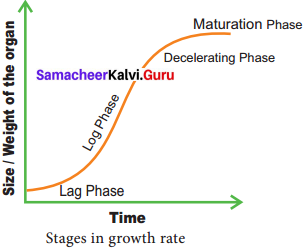
Question 3.
Write the Internal conditions for growth Internal factors.
Answer:
- Genes
- Phytohormones
- C/N Ration: The ratio of carbohydrates and Nitrogenous compounds regulate the specific pattern of growth in plants.
Question 4.
What are the characteristic features of phytohormones?
Answer:
- Usually produced in tips of roots, stems and leaves.
- Transfer of hormones “from one place to another takes part through conductive systems.
- They are required in trace quantities.
- AH hormones are organic in nature.
- There are no specialized cells or organs for their secretion.
- They are capable of influencing physiological activities leading to promotion, inhibition and modification of growth.
Question 5.
Write about the history of the discovery of Cytokinin.
Answer:
- Haberlandt (1913): The presence of cell division inducing substance was demonstrated in coconut milk (liquid endosperm)
- Skoog & Miller (1954): Autoclaved DNA from Herring fish sperm stimulated cell division in tobacco pith cells.
- Lethan (1963): Introduced the term Cytokinin
- Lethan & Miller: Isolated & Identified a new Cytokinin called Zeatin from unripe maize grain
- The most widely occurring cytokinin in plants is ISO Pentenyl adenine (IPA).
Question 6.
Mention any three physiological effects of gibberellins.
Answer:
- It produces an extraordinary elongation of stem caused by cell division and cell elongation.
- Rosette plants (genetic dwarfism) plants exhibit excessive inter-modal growth when they are treated with gibberellins. This sudden elongation of a stem followed by flowering is called bolting.
- Gibberellin breaks dormancy in potato tubers.
Question 7.
What is the Agricultural role of Ethylene?
Answer:
- Reduces flowering: It normally reduces flowering in plants except in Pineapple & Mango.
- Increases the female flower: It increases the number of females (O) flowers and decreases the number of male (O) flowers.
- Increases yield or production of fruits: Ethylene spray in cucumber crops produces female flowers and increases the yield.
Question 8.
What is meant by climacteric fruits?
Answer:
In most plants, there is a sharp rise in respiration rate near the end of the development of fruit, called climacteric rise. Such fruits are called climacteric fruits. The ripening on demand can be induced in these fruits by exposing them to normal air containing about 1 ppm of ethylene. A liquid called ethephon is being used in fruit ripening as it continuously releases ethylene, eg: Tomato, Apples, Banana, Mango.
Question 9.
Give the classification of plants based on photoperiodism.
Answer:
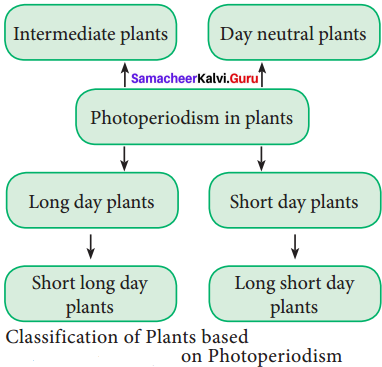
Question 10.
Explain the term photoperiodic induction.
Answer:
An appropriate photoperiod in 24 hours cycle constitutes one inductive cycle. Plants may require one or more inductive cycles for flowering. The phenomenon of conversion of leaf primordia into flower primordia under the influence of suitable inductive cycles is called photoperiodic induction.
eg: Xanthium (SDP) – 1 inductive cycle and Plantago (LDP) – 25 inductive cycles.
Question 11.
What are the practical applications of vernalization in plants?
Answer:
- Vernalization shortens’ the vegetative period and induces the plant to flower earlier.
- It increases the cold resistance of the plants.
- It increases the resistance of plants to fungal disease.
- Plant breeding can be accelerated.
Question 12.
Write down the internal factors, that affect seed germination.
Answer:
1. Maturity of embryo:
The seeds of some plants, when shed will contain immature embryo. Such seeds germinate only after maturation of embryo.
2. Viability:
Usually seeds remain viable or living only for a particular period. Viability of seeds range from a few days (eg: Oxalis) to more than hundred years. Maximum viability (1000 years) has been recorded in lotus seeds. Seeds germinate only within the period of viability.
3. Dormancy:
Seeds of many plants are dormant at the time of shedding.
Question 13.
What is the physiology of senescence?
Answer:
- Change in the structure of cells
- Vacuoles act like lysosome – secrete hydrolytic enzymes.
- Reducation in photosynthetic rate (due to loss of chlorophyll & accumulation of anthocyanin)
- Decrease in – Starch content, Protein content
- Decrease in r RNA level due to increased activity of enzyme RNA ase
- Degeneralion of DNA – by increased activity of enzyme DNA ase
Question 14.
What are the significances of abscission?
Answer:
- Abscission separates dead parts of the plant, like old leaves and ripe fruits.
- It helps in dispersal of fruits and continuing the life cycle of the plant.
- Abscission of leaves in deciduous plants helps in water conservation during summer.
- In lower plants, shedding of vegetative parts like gemmae or plantlets help in vegetative reproduction.
IV. Answer the following (5 Marks)
Question 1.
Describe the geometric growth rate in plants with suitable diagram.
Answer:
Geometric growth rate:
This growth occurs in many higher plants and plant organs and is measured in size or weight. In plant growth, geometric cell division results if all cells of an organism or tissue are active mitotically. eg: Round three in the given figure, produces 8 cells as 23 – 8 and after round 20 there are 220 = 1,048,576 cells. The large plant or animal parts are produced this way. In fact, it is common in animals but rare in plants except when they are young and small. Exponential growth curve can be expressed as,
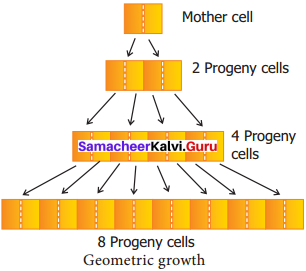
W1 = W0ert
W1 = Final size (weight, height and number)
W0 = Initial size at the beginning of the period
r = Growth rate
t = Tittle of growth
e = Base of the natural logarithms
Here V is the relative growth rate and also a measure of the ability of the plant to produce new plant material, referred to as efficiency index. Hence, the final size of W1 depends on the initial size W0.
Question 2.
Describe the experiment to measure the increase in the length of the stem tip using an arc auxanometer.
Answer:
The increase in the length of the stem tip can easily be measured by an arc auxanometer which consists of a small pulley to the axis of which is attached a long pointer sliding over a graduated arc. A thread one end of which is tied to the stem tip and another end to weight passes over the pulley tightly.
As soon as the stem tip increases in length, the pulley moves, and the pointer slide over the graduated arc (Figure). The reading is taken. The actual increase in the length of the stem is then calculated by knowing the length of the pointer and the radius of the pulley. If the radius of the pulley is 4 inches and the length of the pointer 20 inches the actual growth is measured as follows:
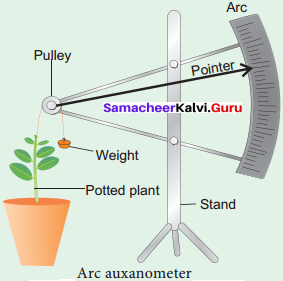

Question 3.
Write an essay on the phytochrome, Gibberelf ns in plants.
Answer:
1. Discovery:
The effect of gibberellins had been known in Japan since early 1800 where certain rice plants were found to suffer from ‘Bakanae’ or foolish seedling disease. This disease was found by Kurosawa (1926) to be caused by a fungus Gibberella fujikuroi. The active substance was separated from fungus and named gibberellin by Yabuta (1935). These are more than 100 gibberellins reported from both fungi and higher plants. They are noted as GA1, GA2, GA3, and so on. GA3 is the first discovered gibberellin. In 1938, Yabuta and Sumiki isolated gibberellin in crystalline form. In 1955, Brain et al gave the name gibberellic acid. In 1961, Cross et al., established its structure.
2. Occurrence:
The major site of gibberellin production in plants is parts like embryo, roots and young leaves near the tip. Immature seeds are rich in gibberellins.
3. Precursors:
The gibberellins are chemically related to terpenoids (natural rubber, carotenoids and steroids) formed by 5 – C precursor, an Isoprenoid unit called Iso Pentenyl Pyrophosphate (IPP) through a number of intermediates. The primary precursor is acetate.
4. Chemical structure:
All gibberellins have gibbane ring structure.
5. Transport in plants:
The transport of gibberellins in plants is non-polar. Gibberellins are translocated through phloem and also occur in xylem due to lateral movement between vascular bundles.
6. Bioassay (Dwarf Pea. assay):
Seeds of dwarf pea are allowed to germinate till the formation of the coleoptile. GA solution is applied to some seedlings. Others are kept under control. Epicotyle length is measured and as such, GA stimulating epicotyl growth can be seen.
7. Physiological Effects:
It produces extraordinary elongation of stem caused by cell division and cell elongation.
- Rosette plants (genetic dwarfism) plants exhibit excessive intermodal growth when they are treated with gibberellins. This sudden elongation of stem followed by flowering is called bolting.
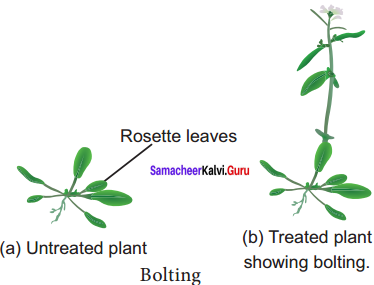
- Gibberellin breaks dormancy in potato tubers.
- Many biennials usually flower during second year of their growth. For flowering to take place, these plants should be exposed to cold season. Such plants could be made to flower without exposure to cold season in the first year itself, when they are treated with gibberellins.
8. Agricultural role:
- Formation of seedless fruits without fertilization is induced by gibberellins eg: Seedless tomato, apple and cucumber.
- It promotes the formation of male flowers in cucurbitaceae. It helps in crop improvement.
Uniform bolting and increased uniform seed production. - Improves number and size of fruits in grapes. It increase yield.
- Promotes elongation of inter-node in sugarcane without decreasing sugar content.
- Promotion of flowering in long day plants even under short day conditions. .
- It stimulates the seed germination
Question 4.
What are their physiological effects of Abscisic acid in – plants and its role in agriculture?
Answer:
Physiological effects:
- It helps in reducing transpiration rate by closing stomata. It inhibits K+ uptake by guard cells and promotes the leakage of malic acid. It results in closure of stomata;
- It spoils chlorophylls, proteins and nucleic acids of leaves making them yellow.
- Inhibition of cell division and cell elongation.
- ABA is a powerful growth inhibitor. It causes 50% inhibition of growth in Oat coleoptile.
- It induces bud and seed dormancy.
- If promotes, the abscission of leaves, flowers and fruits by forming abscission layers.
- ABA plays an important role in plants dtiring water stress -and during drought conditions. It results in loss of turgor and closure of stomata,
- It has anti-auxin and anti-gibberellin properties.
- Abscisic acid promotes senescence in leaves’ by causing loss of chlorophyll pigment decreasing the rate of photosynthesis and changing the rate of proteins and nucleic acid synthesis
Agricultural Role:
- In Cannabis sativa, induces male flower formation on female plants.
- Induction of flowers in short-day plants.
- It promotes sprouting in storage organs like Potato.
- ABA plays an important role in plants during water stress drought conditions.
- It inhibits the shoot growth and promotes growth of root system. This character protect the plants from water stress. Hence, ABA is called stress hormone.
Question 5.
Write down the Agricultural role of gibberellins.
Answer:
- Induces parthenocarpy – (Seedless fruits) Eg. Tomato, Apple & Cucumber
- Promotes the formation of male flowers Eg. Cucurbitaceae
- Increases uniform bolting & uniform seed production.
- Increases yield also increase the number and size of fruits in grapes
- Increases elongation of sugar cane internodes
- Promotes flowering in L.D. Plants even under S .D. conditions.
- Stimulates seed germination.
Question 6.
Explain the two hypotheses of explaining the mechanism of vernalization.
Answer:
Two main theories to explain the mechanism of vernalization is:
1. Hypothesis of phasic development:
According to Lysenko, the development of an annual seed plant consists of two phases. The first phase is a thermostat, which is a vegetative phase requiring low temperature and suitable moisture. The next phase is photo stage which requires high temperature for the synthesis of florigen (flowering hormone).
2. Hypothesis of hormonal involvement:
According to Purvis (1961), the formation of a substance A from its precursor is converted into B after chilling. Substance B is unstable. At suitable temperature, B is converted into stable compound D called Vemalin. Vernalin is converted to F (Florigen). Florigen induces flower formation. At high-temperature B is converted to C and decimalization occurs.
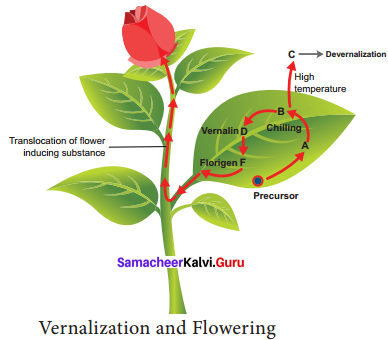
Question 7.
Write an essay on the types of senescence, its physiology, and the factors affecting senescence.
Answer:
1. Types of Senescence:
Leopold (1961) has recognized four types of senescence.
(a) Overall senescence:
This kind of senescence occurs in annual plants when the entire plant gets affected and dies, eg: Wheat and Soybean. It also occurs in few perennials also, eg: Agave and Bamboo.
(b) Top senescence:
It occurs in aerial parts of plants. It is common in perennials, underground and root system remains viable, eg: Banana and Gladiolus.
(c) Deciduous senescence:
It is common in deciduous plants and occurs only in the leaves of plants, the bulk of the stem and root system remains alive, eg: Elm and Maple.
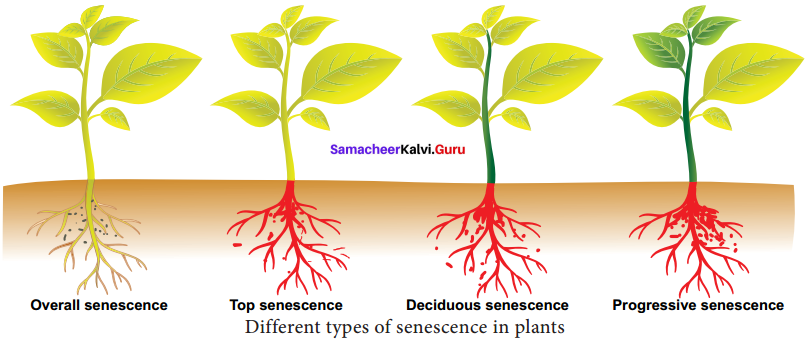
(d) Progressive senescence:
This kind of senescence is gradual. First it occurs in old leaves followed by new leaves f then stem and finally root system. It is common in annuals.
2. Physiology of Senescence:
- Cells undergo changes in structure.
- Vacuole of the cell acts as a lysosome and secretes hydrolytic enzymes.
- The starch content is decreased in the cells.
- Photosynthesis is reduced due to loss of chlorophyll accompanied by synthesis and accumulation of anthocyanin pigments, therefore the leaf becomes red.
- There is a marked decrease in protein content in the senescing organ.
- RNA content of the leaf particularly rRNA level is decreased in the cells due to increased activity of the enzyme RNAase.
- DNA molecules in senescence leaves degenerate by the increased activity of enzyme DNAase.
3. Factors affecting Senescence:
- ABA and ethylene accelerate senescence while auxin and cytokinin retard senescence.
- Nitrogen deficiency increases senescence whereas nitrogen supply retards, senescence. High-temperature senescence but low retards senescence.
- Senescence is rapid in dark than in light.
- Water stress leads to the accumulation of ABA leading to senescence.
Question 8.
Give the physiological effects of ABA Closure of stomata
Answer:
- ABA inhibit K+ uptake by guard calls and promotes the leakage of malic acid lead to closure of stomate and reduces transpiration rate.
- It result in loss of turgor pressure and closure of stomata, thus helps in sol ving water stress dirung drought condition (stress – phytohormone)
Changes leaf colour to yellow :
It spoils chlorophylls, proteins and nucleic acids and turn leaves into yellow.
- Inhibitor of growth
- Inhibit cell division and cell elongation
- It causes 50% inhibition of growth in oat coleoptiles
- Induces bud & seed dormancy
Promotes abscission of
- leaves
- fruits
- flowers
Promotes senescence
Causing loss of chlorophyll pigment decreasing rate of photosynthesis, rate of protein synthesis, and nucleic acid synthesis causing senescence.
Solution To Activity
Textbook Page No: 164
Question 1.
Demonstration of phases of growth.
Answer:
To demonstrate and study the phases of growth, germinate a few seeds of bean on a circular filter paper soaked with water in a Petri dish. After two days of growth, select a few seedlings with a straight radical of 2 to 3 cm in length. Dry the surface of the radical with blotting paper and mark the radical from tip to base with at least 2 mm gap using waterproof ink. Replace the seedlings in filter paper and observe further growth.
Observation:
The marked area in the radical will grow and increase in length and hence the marked area of 2mm is found to be grow beyond 2mm size due to the growth in the radical.
Textbook Page No: 169
Question 2.
Measurement of growth by direct method.
Answer:
Step 1: Take ordinary scale.
Step 2: Measure ground stem up to the growing point of the plant.
Step 3: Use Indian ink and mark at regular intervals to measure the length of root, stem, and girth of the trunk.
Observation:
At regular intervals measure the increase in length and girth of the trunk and it can be observed that the length of the root, stem and girth of the trunk increased with the increase in the period of growth.
Hope all the information given regarding Class 11th Tamilnadu State Board Bio Botany Solutions will help you to get good knowledge. For any queries, you can contact us and clear your doubts. Connect with us using the comment section. Also, we love your feedback and review. Get your Chapter Wise Samacheer Kalvi Class 11th Textbook Solutions for Bio Botany Solutions Chapter 15 Plant Growth and Development Questions and Answers PDF start learning for the exam.